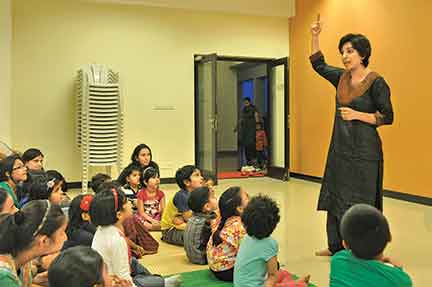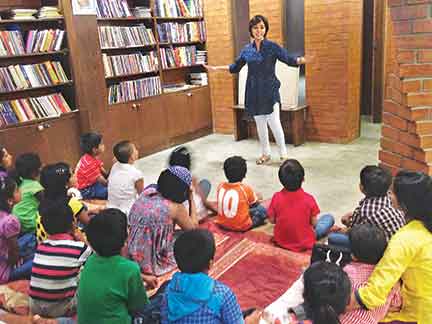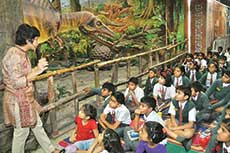Deeptha Vivekanand
James Comer, the Maurice Falk Professor of Child Psychiatry at the Yale University Child Study Centre, says, “No significant learning occurs without a significant relationship. As a practitioner of storytelling since 2009, I have every reason to believe that nothing brings people closer than stories.” Humans communicate best through stories for they are hard-wired to process information in the form of narrative. While we process hard facts, we do so rather reluctantly. There is enough valid, proven research in the field of neuroscience that supports the use and impact of stories on learning and decision-making. Storytelling isn’t just a simple bedtime activity between a parent and child anymore, but a scientific way for people across the world to exchange ideas, inspire each other and bring about change. This only underscores the fact that teachers, educators, and trainers are the best people on earth to tell stories that form strong classroom bonds with their learners through this wonderfully engaging medium.
 Based on The Story Factor by Annette Simmons, which talks about six stories every business leader and manger must learn to tell, I have here a list of three kinds of stories that I believe every teacher and educator must include in their repertoire. Whether it is inside your classrooms, at meetings, or conferences you may attend, each of the following stories presents an opportunity to show a little bit of your soul to your listeners, creating a circle of trust and support with those you encounter.
Based on The Story Factor by Annette Simmons, which talks about six stories every business leader and manger must learn to tell, I have here a list of three kinds of stories that I believe every teacher and educator must include in their repertoire. Whether it is inside your classrooms, at meetings, or conferences you may attend, each of the following stories presents an opportunity to show a little bit of your soul to your listeners, creating a circle of trust and support with those you encounter.
‘What-made-you-a-teacher’ story: It’s the beginning of the school year. You enter a classroom full of students you have never met. There is a look of excitement on some faces, boredom on some, naughtiness and indifference on some others. How do you break the ice? Sure, there are tons of games and exercises you can do together, but how about sharing your story with them? A personal story that defines you as a teacher. Debi Talukdar, a teacher and Ph.D. student at the University of Washington had this to say when I asked her to share a story she tells her class: “This is what I tell my philosophy class (3rd graders) about why I do philosophy with them: I grew up in a school that didn’t allow us to ask many questions. This was sad because I am a curious person and my curiosity died a little. The teacher simply told us stuff, and we learnt it for tests. When I grew up I realized that I was having the most interesting conversations with people when someone asked a question. I discovered that asking questions helps us learn so much about the world and ourselves. Even though I didn’t have many chances to ask questions when I was in school, I like to create chances for kids like you to ask questions about things we don’t spend much time talking about in class like love, life, friendship, fairness, or honesty. That’s why I love doing philosophy and I hope soon you’ll love it as much as I do!” Through her story, Debi instils in her students the power to question, share thoughts and wonder about important things in life without really being academic about it. Sharing a bit about her past, present, and future with students helps them see her as a person first and then as a teacher of a subject. This is what makes personal storytelling so powerful. In the world of storytelling, there is a growing focus on the importance of sharing personal stories to counter the increasing isolation brought about by our reliance on technology and social media. By telling a personal story, the educator automatically encourages students to contribute their stories too, which leads to a culture of support within the classroom.
 Teaching stories: As I was talking to a group of teachers during a storytelling workshop, one of them said, “It’s very easy to find stories to tell young children, but what about the older ones?” “What about stories to teach concepts in science or maths?” Whatever be the subject or grade level, a teacher who has the time and patience to look for appropriate stories will find hundreds of them in folklore, legend, myth, and popular culture. It is truly amazing to see how concepts in science and maths have been cleverly embedded in the ancient stories of world cultures. For example, the story about how Sissa, the man who created the game of chess, won his reward of rice is a great way to introduce powers, indices and geometric progressions. For higher grades, it can be used to trigger discussion on the exponential growth theory in economics and cell multiplication in biology as well. Or the popular fairy tale Goldilocks can be used to explain how the laws of thermodynamics have been violated! A teacher may also adapt an existing story or create her/his own story from scratch to illustrate an abstract concept. All it needs is an open mind that allows you to make connections with seemingly disparate ideas. After all, it is not without reason that the Native American proverb goes: ‘Tell me a fact and I’ll learn; tell me a truth and I’ll believe; but tell me a story and it’ll live in my heart forever.’
Teaching stories: As I was talking to a group of teachers during a storytelling workshop, one of them said, “It’s very easy to find stories to tell young children, but what about the older ones?” “What about stories to teach concepts in science or maths?” Whatever be the subject or grade level, a teacher who has the time and patience to look for appropriate stories will find hundreds of them in folklore, legend, myth, and popular culture. It is truly amazing to see how concepts in science and maths have been cleverly embedded in the ancient stories of world cultures. For example, the story about how Sissa, the man who created the game of chess, won his reward of rice is a great way to introduce powers, indices and geometric progressions. For higher grades, it can be used to trigger discussion on the exponential growth theory in economics and cell multiplication in biology as well. Or the popular fairy tale Goldilocks can be used to explain how the laws of thermodynamics have been violated! A teacher may also adapt an existing story or create her/his own story from scratch to illustrate an abstract concept. All it needs is an open mind that allows you to make connections with seemingly disparate ideas. After all, it is not without reason that the Native American proverb goes: ‘Tell me a fact and I’ll learn; tell me a truth and I’ll believe; but tell me a story and it’ll live in my heart forever.’
Inspiration stories: These are tales of real life heroes, leaders, scientists, mathematicians – both successful and failed. These stories need not be reserved only for value education or life skills classes. Teachers of maths, science, and social sciences could tell lesser-known stories of figures in their respective fields to build interest and humanize the subject. An example is the story of the ‘war’ between Newton and Leibniz in the creation of calculus. It’s a fascinating story that takes calculus beyond just a set of abstract symbols and directs the discussion to why it was a cause of so much friction between two great minds and therefore the context behind why the derivation of calculus was a matter of great pride. A history class on World War II could begin with a fictional conversation between Mandela and Hitler. Learners benefit immensely from listening to these stories as they help them establish deep emotional connections with the subject because they touch upon the vulnerabilities of famous people; this makes their study more relatable and engrossing. A student may then be motivated to seek out more information about the person, as an extension of the story.
 Telling stories is an art and a skill but more importantly, in today’s tap-and-go world, it is a pressing need. Stories break down information into processable chunks and help make sense of this world. The ‘teacher as a storyteller’ is a role that must be embraced more widely — both from the standpoint of the teacher’s personal effectiveness and that of the value and impact she/he creates while delivering sessions. It is my hope that teachers and educators, upon reading this article, will feel motivated to look for stories from within them and the world outside. And most importantly, share them with their students and peers.
Telling stories is an art and a skill but more importantly, in today’s tap-and-go world, it is a pressing need. Stories break down information into processable chunks and help make sense of this world. The ‘teacher as a storyteller’ is a role that must be embraced more widely — both from the standpoint of the teacher’s personal effectiveness and that of the value and impact she/he creates while delivering sessions. It is my hope that teachers and educators, upon reading this article, will feel motivated to look for stories from within them and the world outside. And most importantly, share them with their students and peers.
The author has been telling stories since 2009 as a performer, trainer, and educator. She is the founder of Ever After Learning in Bengaluru, a venture that works to promote the use of stories and storytelling in the curriculum. She works with teachers and schools to help them create story-based solutions that make learning lively, impactful and long-lasting. She can be reached at deeptha@ever-after.co.in.
